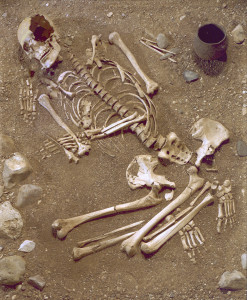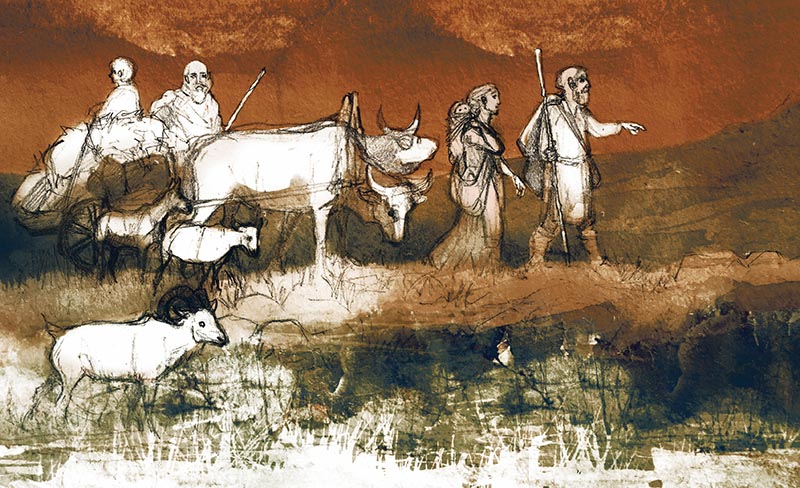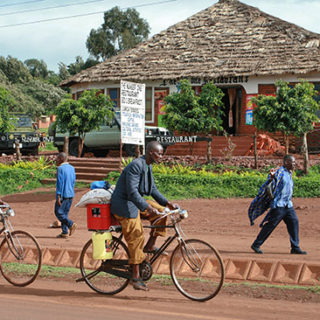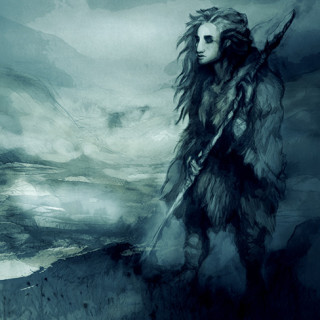Prehistoric migration uncovered with the help of DNA
The people who lived in Scandinavia before us – who were they and where did they come from? To find the answers, archaeologists and osteologists have previously grouped and dated excavated objects and skeletal remains from various prehistoric cultures. With the help of DNA studies, researchers have now begun to understand how these humans are related to one another, and how they must have moved over thousands of years. An image of major flows of migration emerges, which not only brought with them new people but also new views and approaches to Scandinavia.
IN ONE EXCAVATION AFTER ANOTHER, researchers since the 1940s have studied and dated arrow heads, axes, tombs and ceramic objects, to try to understand the prehistoric human way of life here in Europe. Archaeologists have defined cultural groups and found similarities and differences between them based on their material remains. The big issue has been whether we in Scandinavia have slowly changed the way we live with the help of ideas from others, or if the changes were brought to us by migrants from other places in the world.
“Migration research is once again becoming interesting. We return to our previous questions to find new answers with the help of osteological methods – DNA and isotope analyses”, says Torbjörn Ahlström, Professor of Historic Osteology.
ACCORDING TO TORBJÖRN AHLSTRÖM, Scandinavian history can be summarised like this:
It starts with the first modern human being, Homo sapiens, wandering out of Africa. Some of these hunter-gatherers made their way towards the northwest 40,000 years ago, and slowly spread across Europe. Some of them followed the reindeer herds north when the inland ices receded, and there is evidence that they existed in Skåne 14,000 years ago. Archaeological remains show that 8,000 years later, that is, about 6,000 years ago, groups of humans started to live as farmers in southern Sweden. With the help of DNA analyses, in 2014 researchers were able to reveal that these farmers arrived as immigrants from the Middle East. These humans were the ones who disseminated knowledge of farming and livestock when making their way through Europe.
“In southern Sweden, these hunter-gatherers were initially almost completely side-lined and marginalised. However, based on the tombs and plenty of discovered objects, we know that about 5,200–4,300 years ago there were both farming communities and hunter-gatherers living by the coast. We can for example see that many people subsisted on seal hunting in the Baltic Sea”, says Torbjörn Ahlström.
“Then something happened some 4,800 years ago – a group of steppe shepherds came to Scandinavia in a third wave of immigration.”
THEN SOMETHING HAPPENED some 4,800 years ago. According to Torbjörn Ahlström, this is the time when new types of objects appear, especially the so-called battle axes, and new types of tombs that differ from those of the early peasants, indicating that these so-called “battle axe people” lived more as nomadic shepherds. Based on the findings, the archaeologists found that a similar culture existed in large parts of Europe. There were also similarities with the so-called Yamnaya culture from the Pontic steppe. The Yamnaya people were horse-mounted shepherds who lived on the steppe with cattle, goats and sheep. Recently, a large research group, including Torbjörn Ahlström, demonstrated that after the Ice Age hunters and Neolithic farmers, this group of steppe shepherds came to Scandinavia in a third wave of immigration. Their results were presented last year in the research journal Nature.
“It is exciting that our Swedish material shows us a clear genetic link between the Yamnaya culture and skeletons from the battle axe culture in Skåne”, says Torbjörn Ahlström.
Most of us who live in Europe today carry traces in our genes, our DNA, from several different cultural groups. We are a blend between the first colonising humans, more recent immigrant farmers from the Middle East, and a shepherd people from steppes in the east. It has been previously shown that from the latest wave of immigration we assimilated the use of horses and carriages, and many researchers believe that even the Indo-European language originated from the Yamnaya shepherds. According to Torbjörn Ahlström, the study presented one surprising result:
“One of the findings from our study that took me by surprise was that the Yamnaya people and their descendants in Scandinavia were lactose intolerant, unable to drink raw milk. Because of our previous finding of lactose tolerance in a person who subsisted on agriculture in Falbygden in the Swedish province of Västergötland 5,200 years ago, we assumed that the same would apply to people in our more recent material of the battle axe people who also carried livestock. Instead, we found that the clearest connection to drinking milk didn’t appear until our most recent material of an individual who lived during the Iron Age in the area of Fosie in Skåne”.

APART FROM STUDYING GENETIC AFFINITY and hereditary properties with the help of DNA, the osteologists apply other methods to study how people have moved over the course of a lifetime, their diet, and whether they have been subjected to violence, etc. By using isotopes, such as strontium, Torbjörn Ahlström and his colleagues are able to see whether or not a particular individual grew up in the same place as they died. Strontium is created when beryllium decays in old bedrock. The older the bedrock of where you grow up, the higher the concentration of strontium there is, and the more is deposited into your tooth enamel.
“As part of the major genetic study, we have taken samples for strontium analyses from 19 skeletons found in Skåne, but the results have not yet been evaluated”, says Torbjörn Ahlström, and continues: “In combination with the results of osteological and archaeological findings, we have in other contexts discovered that individuals who differ in terms of where they grew up have become integrated into the culture to which they moved”.
From osteological studies of skeletons of the battle axe people, as well as the skeletons of former hunting societies, the researchers have also discovered that there was a lot of violence during these periods.
“The way in which we interpret injuries has been revolutionised. Previously, we believed that there was no violence, but now we interpret many of the injuries we see as consequences of violence and not symbolic actions”, says Torbjörn Ahlström.
According to Torbjörn Ahlström, the development of all these different techniques will enable researchers in the future to tackle issues to which they previously only dreamed of finding an answer:
“I think the most exciting thing to address would be the colonisation phase here in Scandinavia. At what point does our own species appear for the first time in this part of the world? How was Scandinavia colonised after the Ice Age? Did these people stay or move on? We will probably discover an even more complicated pattern than we previously thought”.
Text: Pia Romare
Illustration: Catrin Jacobsson
Facts
-
The study Population Genomics of Bronze Age Eurasia
-
The results presented in the study Population Genomics of Bronze Age Eurasia are based on studies of a total of 101 Euro-Asian skeletons from different periods during the Bronze Age. The study of fossil DNA was previously very time-consuming, and the studies were most often based on only a few individuals.
To analyse fossil DNA you start by extracting usable amounts of genetic material from bones. Then it is important to distinguish fossil DNA from more recent DNA, and then finally piece all the fragments together on the computer. The method has been developed over the past two decades, pioneered by the Swedish researcher Svante Pääbo. He published the first analysis of DNA from human fossils in 1997. Since then, the various stages of the method have developed rapidly, and in the study Population Genomics of Bronze Age Eurasia it is primarily the improvement of the procedure for extracting usable amounts of genetic material that has enabled the inclusion of such a large quantity of study materials.
-
Osteology
-
Osteology is the study of the skeletons of vertebrates, including humans. Osteological knowledge can be used to, for instance, determine the sex, age and state of health of a human skeleton from archaeological excavations (historical osteology).
-
Isotope analyses
-
Osteologists analyse isotopes (atoms of the same element but of different mass) based on small bone and tooth samples from skeletons. With the help of the isotopes from various basic elements, they can:
- date organic materials (carbon isotope 14C)
- determine their diet (carbon isotope 13C and nitrogen isotope 15N)
examine whether a person was born in the same area in which they were discovered, or if they moved (strontium isotopes)





